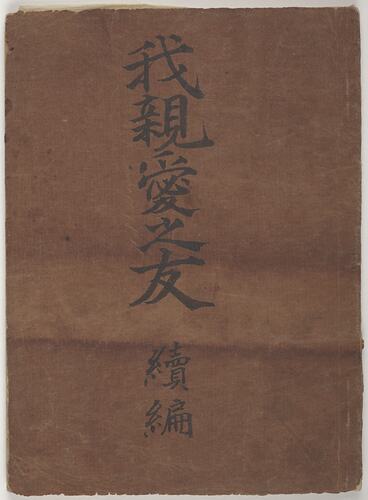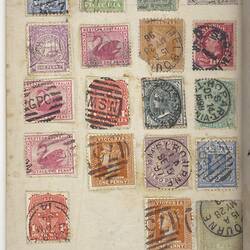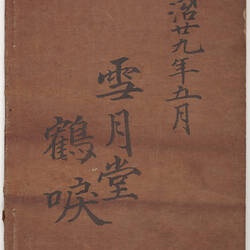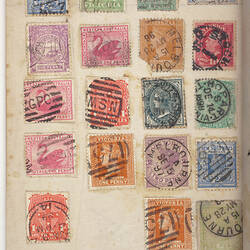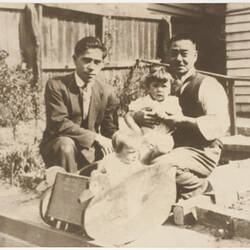Summary
Diary belonging to Setsutaro Hasegawa, used circa 1900. It contains a page of postage stamps, which are mostly dated 1898, indicating an interest by Setsutaro in collecting stamps from around the pre-Federated states. Setsutaro migrated to Australia from Japan in 1897 at the age of 26, just four years before the introduction of the Immigration Restriction Act which severely limited migration to Australia from countries in Asia. He established a laundry business in Geelong and by 1911 he had married an Australian-born woman and had three children.
In 1941 Setsutaro was arrested as an enemy alien and sent to Tatura internment camp in northern Victoria. Released early in 1943 due to his age and poor health, unlike most Japanese interns he was not deported to Japan after the War. Setsutaro remained in Geelong for the rest of his life and died in 1952.
The words on the covers of this diary have not been translated but the quality of the calligraphy suggests Setsutaro was well educated, and grew up in a family where education was valued. The calligraphy is beautiful, it requires much practice and great skill. His father was a finance officer working for the government. This was a typical outcome for the former samurai class who following the fall of the Tokugawa regime no longer served the daimyo (feudal lords). There were many diaries written by Setsutaro, unfortunately no one over the generations could read them and over time they were lost.
Physical Description
Brown soft covered booklet with Japanese characters in black ink on both sides and a string binding. The pages are possibly rice paper, and are most blank. The second and third pages feature Japanese text in ink and pencil. The fourth page has 19 postage stamps glued in, 17 of which are from various Australian states, the other two are from Sweden and Egypt. The stamps are mostly dated 1898.
Significance
The Hasegawa collection enables the exploration of a number of important historical themes relating to migration, working life, and wartime internment in Victoria. Late nineteenth century and early to mid twentieth century Japanese migration and settlement experiences are little represented in the museum's collections and this collection of clothing, documents, personal items and photographs helps to redress.
More Information
-
Collecting Areas
-
Acquisition Information
Donation from Andrew Hasegawa, Andrew Hasegawa, 08 Feb 2008
-
Author
-
Place & Date Purchased
-
Inscriptions
Extensive Japanese text.
-
Classification
-
Category
-
Discipline
-
Type of item
-
Overall Dimensions - Folded
125 mm (Width), 171 mm (Height)
-
References
5 family photographs (need originals from donor to scan)
-
Keywords
Diaries, Immigration, Immigration Policies, Japanese Communities, Japanese Culture, Japanese Immigration, Stamps
